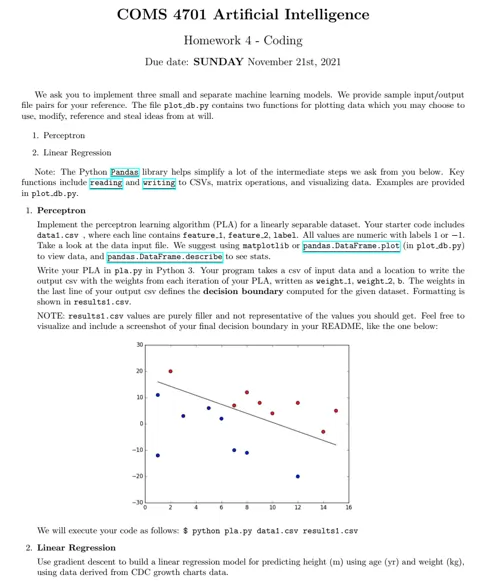Instructions
Objective
Write a python assignment program to create linear regression and perceptron.
Requirements and Specifications

Source Code
LINEAR REGRESSION
import numpy as np
import pandas as pd
import sys
from plot_db import *
def gd(x, y, m1, m2, b, learning_rate, iters = 100):
"""
Implement Gradient Descent Algorithm
:param x: x-values. NumPy Array of two columns and N rows
:param y: y-values
:param m1: slope for variable x1
:param m2: slope for variable x2
:param b: intercept
:param learning_rate: learning rate
:param iters: Number of iterations
:return: optimized values of m and b
"""
N = len(y) # number of points
for i in range(iters):
y_new = m1*x[:,0] + m2*x[:,1] +b
cost = sum([k**2 for k in (y-y_new)])/N
b_gradient = -(2/N)*sum(y-y_new)
m1_gradient = -(2/N)*sum(x[:,0]*(y-y_new))
m2_gradient = -(2/N)*sum(x[:,1]*(y-y_new))
# Update values of m and b
m1 -= learning_rate*m1_gradient
m2 -= learning_rate * m2_gradient
b -= learning_rate*b_gradient
return m1, m2, b
def main():
"""
YOUR CODE GOES HERE
Implement Linear Regression using Gradient Descent, with varying alpha values and numbers of iterations.
Write to an output csv file the outcome betas for each (alpha, iteration #) setting.
Please run the file as follows: python3 lr.py data2.csv, results2.csv
"""
if len(sys.argv) < 3:
print("You must provide the input file and the output file as arguments.")
sys.exit()
input_file = sys.argv[1]
output_file = sys.argv[2]
# Read input file
input_data = pd.read_csv(input_file, header=None).values
x = input_data[:, :2]
y = input_data[:,2]
# Normalize the columns in x such that they have a mean zero
x[:,0] = (x[:,0] - np.mean(x[:,0]))/np.std(x[:,0])
x[:, 1] = (x[:, 1] - np.mean(x[:, 1])) / np.std(x[:, 1])
# Use Gradient Descent Algorithm for different learning rates
alpha_vals = np.array([0.001, 0.005, 0.01, 0.05, 0.1, 0.5, 1, 5, 10])
fig = plt.figure()
ax = fig.add_subplot(111, projection='3d')
errors = []
N = len(y)
# Create the array to store the values to be written in the output file
output_vals = np.zeros((10, 5))
num_iters = 100
for i, alpha in enumerate(alpha_vals):
# predict using gradient descent
m1, m2, b = gd(x, y, 1, -1, 0, alpha, num_iters)
# Compute prediced values
y_predict = m1*x[:,0] + m2*x[:,1] + b
errors.append(sum([k**2 for k in (y-y_predict)])/N)
output_vals[i, :] = np.array([alpha, num_iters, b, m1, m2])
ax.scatter(x[:, 0], x[:, 1], y_predict, marker='o', label=f"alpha = {alpha}")
ax.scatter(x[:, 0], x[:, 1], y, c='b', marker='o', label='Data')
ax.set_xlabel('X1-axis')
ax.set_ylabel('X2-axis')
ax.set_zlabel('Y-axis')
plt.legend()
plt.show()
print(errors)
"""
From the errors printed, the minimum error obtained is 0.0047281... for alpha = 0.5
So now, we will use this alpha and more iterations to obtain a better result
"""
fig = plt.figure()
ax = fig.add_subplot(111, projection='3d')
# predict using gradient descent
alpha = 0.5
num_iters = 1000
m1, m2, b = gd(x, y, 1, -1, 0, alpha, num_iters)
# Compute prediced values
y_predict = m1 * x[:, 0] + m2 * x[:, 1] + b
error = sum([k**2 for k in (y-y_predict)])/N
ax.scatter(x[:, 0], x[:, 1], y_predict, marker='o', label=f"alpha = {alpha}")
ax.scatter(x[:, 0], x[:, 1], y, c='b', marker='o', label='Data')
ax.set_xlabel('X1-axis')
ax.set_ylabel('X2-axis')
ax.set_zlabel('Y-axis')
plt.legend()
plt.show()
output_vals[9, :] = np.array([alpha, num_iters, b, m1, m2])
print(f"The error obtained for alpha = {alpha} and 1000 iterations is: {error}")
# Finally, write the output file
np.savetxt(output_file, output_vals, delimiter=',', fmt='%.4f')
if __name__ == "__main__":
main()
PERCEPTION
import pandas as pd
import numpy as np
import sys
import matplotlib.pyplot as plt
# Define the function to predict
def predict(x, weights, bias):
y_ = np.dot(x, weights) + bias
return 1.0 if y_ > 0.0 else -1.0
def pla(x, y, learning_rate, epochs = 100, output_file='results1.csv'):
# Get number of features and samples
n_samples, n_features = x.shape
# Initialize weights
weights = np.zeros(n_features)
# Initialize bias
bias = 0.0
# Create array to store the values to be saved into the csv file
output_vals = np.zeros((epochs, n_features + 1))
# Now, iterate
for i in range(epochs):
# Pick each row in the features
for j in range(n_samples):
xi = x[j, :]
# Compute predicted value
y_ = predict(xi, weights, bias)
# Compute difference
dy = (y[j] - y_)
# Update weights and bias
weights += learning_rate*dy*xi
bias += learning_rate*dy
output_vals[i,:] = np.array([weights[0], weights[1], bias])
# Print weights and bias
# Save csv file
np.savetxt(output_file, output_vals, delimiter=',', fmt='%.4f')
# Finally, return weights and bias
return weights, bias
def main():
'''YOUR CODE GOES HERE'''
# First, read input file
if len(sys.argv) < 3:
print("You must provide the input file and the output file as arguments.")
sys.exit()
input_file = sys.argv[1]
output_file = sys.argv[2]
# Read input file
input_data = pd.read_csv(input_file, header=None, names= ['feature1', 'feature2', 'label'])
# Extract x and y values
data_np = input_data.values
x = data_np[:,:2]
y = data_np[:, 2]
n_samples, n_features = x.shape
# Now compute
weights, bias = pla(x, y, 0.1, 100)
# Predict
y_ = np.zeros((n_samples, 1))
for i in range(n_samples):
xi = x[i,:]
y_[i] = predict(xi, weights, bias)
# Compute accuracy
y = y.astype('int')
y_ = y_.astype('int')
print("The accuracy is: {:.2f}%".format(len(np.where(y==y_.T[0])[0])/n_samples *100.0))
# Plot
fig, ax = plt.subplots(nrows = 1, ncols = 2)
"""
Plot data
"""
# Pick values with label == -1
x1 = x[np.where(y==-1), 0]
x2 = x[np.where(y==-1), 1]
ax[0].scatter(x1, x2, c='red', marker='o', label = 'y = -1')
# Values with label == 1
x1 = x[np.where(y == 1), 0]
x2 = x[np.where(y == 1), 1]
ax[0].scatter(x1, x2, c='blue', marker='o', label = 'y = 1')
ax[0].set_title('Original Data')
"""
Plot predicted labels
"""
# Pick values with label == -1
x1 = x[np.where(y_ == -1), 0]
x2 = x[np.where(y_ == -1), 1]
ax[1].scatter(x1, x2, c='red', marker='o', label='y = -1')
# Values with label == 1
x1 = x[np.where(y_ == 1), 0]
x2 = x[np.where(y_ == 1), 1]
ax[1].scatter(x1, x2, c='blue', marker='o', label='y = 1')
ax[1].set_title('Predicted Data')
plt.show()
if __name__ == "__main__":
"""DO NOT MODIFY"""
main()
Related Samples
Explore our collection of free machine learning assignment samples to gain insights into our approach and expertise. These samples showcase our solutions to various machine learning problems, demonstrating our commitment to quality and proficiency in the field.
Machine Learning
Machine Learning
Machine Learning
Machine Learning
Machine Learning
Machine Learning
Machine Learning
Machine Learning
